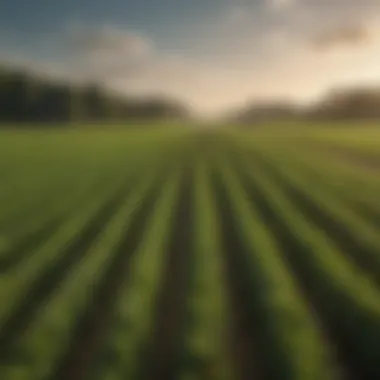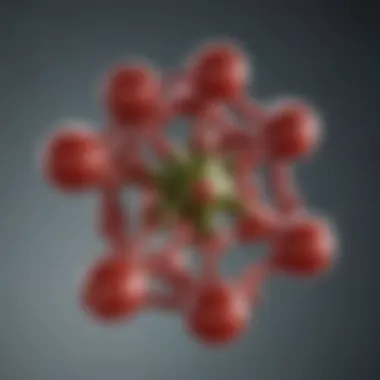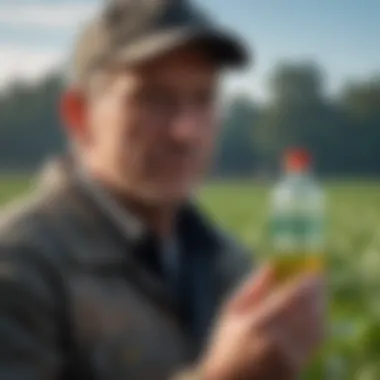Exploring Paraquat: Herbicide Applications and Risks


Intro
Paraquat is a widely used herbicide known for its effectiveness in controlling various weeds and unwanted vegetation. As agricultural practices continue to evolve, understanding paraquat's role is crucial for farmers and agronomy enthusiasts alike. The complexity surrounding its use, safety, and regulatory status requires a detailed examination. This section will present an overview of paraquat, emphasizing its significance and historical context.
Topic Overview
Definition and Importance
Paraquat, scientifically known as paraquat dichloride, is a contact herbicide primarily employed for the rapid desiccation of weeds before crop harvest. Its rapid action makes it a valuable tool in managing plant competition, allowing for improved yields and easier harvesting. The herbicide works effectively against a broad spectrum of annual and perennial weeds, offering a quick solution for critical issues in crop management.
Brief History and Evolution
First introduced in the 1960s, paraquat gained popularity in agricultural sectors for its efficiency and speed. Over the years, its applications have expanded beyond traditional farming, leading to its use in various horticultural and landscaping practices. However, the increasing reliance on paraquat has raised significant concerns regarding safety and environmental impact. Understanding its journey through different eras helps to contextualize present-day applications and regulatory frameworks.
Key Techniques and Innovations
Sustainable Farming Practices
In the context of sustainable agriculture, paraquat must be integrated with sustainable farming practices. These practices include crop rotation, integrated pest management, and minimum tillage, which aim to enhance soil health and reduce chemical dependency. The judicious use of paraquat in conjunction with these methodologies can lead to a balanced approach in weed management while minimizing risks associated with herbicide overuse.
Advanced Agronomic Technologies
Technological advancements in agriculture are transforming how paraquat and other herbicides are applied. Precision farming utilizes GPS technology and data analytics to optimize application rates, reducing waste and limiting potential negative impacts on non-target organisms. These innovations are vital for ensuring that substances like paraquat are used responsibly, thus maintaining agricultural productivity while promoting environmental stewardship.
Practical Applications
Step-by-Step Guides
Implementing paraquat requires precise application techniques to ensure effectiveness and safety. Farmers are advised to:
- Identify Target Weeds: Recognize specific weed species present in the field.
- Select Appropriate Formulation: Choose between liquid or granular formulations based on need.
- Calibrate Equipment: Ensure sprayers and other application devices are properly calibrated to dispense the correct dosage.
- Timing: Apply paraquat during dry weather conditions for maximum efficacy.
- Follow Safety Protocols: Use protective gear and follow local regulations during application.
Case Studies or Real-World Examples
Real-world applications of paraquat illustrate its practical benefits. For example, a study from Queensland, Australia, highlighted how its use in sugarcane crops significantly reduced weed competition, leading to increased cane yield. However, the same study underscored the importance of adhering to safety measures to prevent adverse health effects among agricultural workers. These examples demonstrate the dual nature of paraquat's application and the need for careful consideration of its impacts.
"Paraquat has shown remarkable efficacy, but its application must be balanced with proper safety measures and environmental considerations."
Understanding Paraquat
Understanding paraquat is essential for both agricultural professionals and enthusiasts who seek to utilize this herbicide effectively. Paraquat has been a significant player in the field of herbicides since its invention. Knowing its chemical properties, the history behind its development, and its particular uses can influence decisions in agricultural practices. This section aims to furnish readers with the foundational knowledge necessary for grasping more complex discussions about paraquat's engagement in modern agriculture.
Chemical Composition of Paraquat
Paraquat, chemically known as 1,1'-dimethyl-4,4'-bipyridinium dichloride, is a bipyridinium herbicide. Its molecular structure allows it to act swiftly in the plant system. The herbicide is highly soluble in water, which aids its penetration through plant tissues. When absorbed, it generates reactive oxygen species (ROS) leading to destructive cellular processes in weeds.
The basic chemical formula of paraquat is C124Cl2N2, showcasing its strong elemental composition. The uniqueness of this herbicide stems from its ability to function through a non-selective method, meaning it affects a wide range of plant species. This characteristic is crucial for farmers aiming to control broadleaf weeds and grasses in diverse crop settings. Educating oneself on the chemical nature of paraquat can enhance the understanding of its effective applications and potential risks in farming practices.
History and Development
The discovery of paraquat dates back to the 1950s, specifically introduced for agricultural use by the company Ciba. Initially, farmers welcomed this herbicide for its effectiveness, particularly in managing perennial and annual weeds. Over the decades, paraquat quickly gained acceptance as a primary tool in various agricultural systems.
However, the advent of its efficacy came paired with growing concerns regarding safety and environmental impacts. Articles in scientific journals began to raise awareness about the potential risks associated with human exposure and ecological effects. As a result, countries introduced regulations to monitor its use while ongoing research continues to focus on the balance between its benefits and risks.
Such historical context highlights the importance of understanding paraquat today. The lessons learned from its development can guide current and future use, ensuring that it remains a valuable tool in agriculture while adhering to safety standards and environmental compliance.
Mechanism of Action


Understanding the mechanism of action of paraquat is essential for evaluating its role in weed management strategies. This section explores how paraquat operates at a biochemical level, shedding light on its efficacy and safety in agricultural practices. The effectiveness of a herbicide heavily relies on its ability to target specific biological processes in pests while minimizing risks to desirable crops. Thus, comprehending how paraquat achieves its herbicidal activity allows for better-informed decisions by farmers and agricultural specialists.
How Paraquat Affects Weeds
Paraquat primarily functions by disrupting the process of photosynthesis in plants. When it is absorbed, paraquat produces reactive oxygen species (ROS) that lead to oxidative damage within the plant cells. This action ultimately results in cell death and desiccation of the weed. The rapid degradation in the photosynthetic capability of weeds is one of the reasons why paraquat is effective against a broad spectrum of unwanted vegetation.
The herbicide is often applied to the leaves and stems of weeds, where it is taken up quickly, leading to visible wilting and eventual death within a few days. Its speed of action is particularly advantageous in time-sensitive agricultural situations where quick control of competing plants is necessary. Additionally, paraquat acts on the roots through translocation, further enhancing its effectiveness against perennial weeds that may resist initial leaf-targeted applications.
Comparison with Other Herbicides
When comparing paraquat with other herbicides, such as glyphosate, there are notable differences in their mechanisms and effectiveness.
- Paraquat :
- Glyphosate :
- Acts quickly, typically within days.
- Disrupts photosynthesis specifically, targeting a wide range of weeds.
- Residues degrade rapidly in soil, posing less risk for subsequent crops.
- Slower-acting, often taking weeks to fully control weeds.
- Works by inhibiting specific enzyme pathways, primarily affecting broadleaf and grassy weeds.
- Higher persistence in soil and potential for off-target effects.
The selection of paraquat over other herbicides may depend on several factors, such as the specific weed type, the timing of application, and the desired crop safety. While paraquat offers rapid control, careful consideration of its safety protocols is crucial. As with all herbicides, an informed understanding of the specific action and efficacy can significantly impact agricultural outcomes.
The impact of paraquat’s mechanism of action emphasizes the necessity of adequate safety training and knowledge for effective application in real-world scenarios.
Paraquat Formulations
The topic of paraquat formulations is essential when discussing its herbicidal applications in agriculture. These formulations determine how effectively paraquat can be applied and its overall impact on weeds. Understanding the different types, along with their specific ingredients, helps farmers and agricultural practitioners make informed choices. This ensures optimal benefits while minimizing potential risks.
Types of Commercial Products
Paraquat is available in several commercial formulations that vary in concentration and usage specifications. Common products include:
- Gramoxone: This is one of the most recognizable brands of paraquat. It is often used for its rapid action against a wide range of weeds.
- Firestorm: This formulation combines paraquat with other chemicals to improve efficacy.
- Paraquat Dichloride: A technical form that serves as a base for producing other formulations.
Each product may have unique advantages, depending on specific weed types and target crops. Effectiveness can vary based on the formulation's concentration and additional ingredients.
Active Ingredients in Formulations
The main active ingredient in all paraquat formulations is, of course, paraquat dichloride. However, formulated products may contain different solvents or surfactants.
Common additional ingredients include:
- Surfactants: These help improve the penetration of paraquat into plant tissues. They can enhance herbicide effectiveness.
- Adjuvants: These assist in optimizing application conditions, ensuring even coverage and better adhesion to leaf surfaces.
- Thickeners: Some formulations contain thickeners to ensure that the product clings to target weeds longer, increasing its effectiveness.
Understanding the role of these active ingredients not only contributes to more effective weed management but also plays a role in minimizing the environmental impact of herbicide application.
"Careful selection of paraquat formulations can significantly enhance weed control while reducing risks to the environment and non-target organisms."
Farmers and enthusiasts must select the correct product and closely follow application guidelines for best results.
Effectiveness in Agricultural Practices
The effectiveness of paraquat in agricultural practices is a vital aspect of its application. Farmers need to understand how paraquat interacts with various weeds and crops. This understanding has direct implications for crop yield, overall farm management, and economic factors. Paraquat's quick action against unwanted vegetation positions it as an essential tool for many agricultural operations.
One key benefit of using paraquat is its ability to control a wide range of weeds effectively. This herbicide targets species that are often resistant to other treatments. Therefore, integrating paraquat can help farmers manage stubborn weeds that threaten their crops. Such targeted application is crucial in maintaining soil health and maximizing productivity.
Moreover, using paraquat can reduce the competition for nutrients, water, and sunlight that weeds pose to crops. This can lead to increased growth rates and harvest yields. However, effectiveness extends beyond just weed control; it also involves considering safety and environmental impact, which will be discussed in subsequent sections.
In addition, farmers must consider the economic viability of paraquat. The cost of product application and the potential for higher crop yields need to align. If paraquat results in significant gains in production, it could justify the investment, making it a strategically important consideration in modern agriculture.
Understanding the usage of paraquat involves two primary aspects:


- Targeting specific weeds: This ensures that the application is efficient and effective.
- Choosing the right timing and technique: Proper timing enhances the efficiency of herbicide applications and minimizes potential negative outcomes.
"The right application technique can significantly enhance the effectiveness of paraquat, ensuring optimal results against weeds."
Successful integration of paraquat into agricultural practices requires careful assessment of these factors. As we delve deeper into the next sections, namely targeting weeds and crop types, and examining optimal application techniques, we will uncover how these elements interact in real farming scenarios.
Safety and Health Risks
Understanding the safety and health risks associated with paraquat is crucial for modern agriculture. Farmers and agricultural practitioners must weigh the benefits of using this potent herbicide against the potential hazards to both human health and the environment. As paraquat is widely recognized for its effectiveness in controlling weeds, it is equally important to address how its application may affect both those applying it and the ecosystems in which it is used.
Human Exposure Risks
Paraquat poses significant human exposure risks, particularly for farm workers. The herbicide can enter the body through skin contact, inhalation, or ingestion. Acute poisoning is a major concern, with symptoms including nausea, vomiting, and respiratory distress. Long-term exposure may lead to more serious health issues, such as lung damage and other systemic effects. According to the National Institute for Occupational Safety and Health, any amount of paraquat exposure requires immediate attention due to its lethal potential.
Proper training in safety protocols is essential. Farmers should ensure that all workers understand how to handle paraquat safely. This includes wearing appropriate personal protective equipment (PPE), such as gloves, masks, and goggles. Being aware of the signs of poisoning and knowing emergency procedures can save lives and reduce health risks significantly.
Moreover, it is important to consider the application techniques used. Ensuring that paraquat is applied during favorable weather conditions can help minimize the risk of drift, which could expose nearby individuals and livestock unintentionally.
Environmental Concerns
The environmental concerns related to paraquat are equally pressing. When paraquat is released into the environment, it can affect non-target plant species, beneficial insects, and even aquatic ecosystems. Its persistence in soil and water can lead to contamination, impacting biodiversity.
The chemical properties of paraquat make it particularly harmful to aquatic life. It degrades slowly in water, resulting in potentially toxic concentrations that can harm fish and other aquatic organisms. This not only disrupts local ecosystems but can also have economic implications for communities reliant on these water sources for fishing and recreation.
"Paraquat is one of the most widely used herbicides worldwide, but its environmental impact can not be overlooked, especially in the context of sustainability in agriculture."
Moreover, farmers should take steps to mitigate these environmental risks by employing best practices for application. This may include techniques like buffer zones, which serve as protective barriers against potential drift and runoff.
Regulatory Landscape
Understanding the regulatory landscape surrounding paraquat is essential for anyone involved in agricultural practices. Regulations play a critical role in determining how, where, and when this herbicide can be used. The importance lies not only in compliance but also in ensuring safety for humans, animals, and the environment. Farmers need to be aware of these guidelines to avoid legal repercussions and ensure effective weed management. Regulations also aim to minimize the risk posed by paraquat, given its potential hazards.
Global Regulations on Paraquat Use
Globally, regulations regarding paraquat vary significantly. Many countries impose stringent controls due to the herbicide's toxicity. In the European Union, for instance, paraquat is banned completely. This move indicates a strong stance on public health and environmental safety. Countries like the United States have restrictions in place but continue to allow its use under specific guidelines. Each region's regulations reflect their environmental policies, healthcare priorities, and agricultural needs.
- Europe: Full ban on paraquat as a precautionary measure.
- United States: Permitted with regulatory requirements aimed at reducing exposure risks.
- Australia: Use is regulated, with guidelines to limit environmental impact.
These differing regulations highlight the need for farmers to stay informed, particularly if they operate internationally or source materials from various regions. Understanding local laws is vital for responsible use and application.
Bans and Restrictions
Bans and restrictions regarding paraquat highlight significant concerns about safety and environmental impact. In jurisdictions where paraquat is permitted, restrictions often stipulate conditions of use to mitigate risks.
- Training Requirements: Farmers and applicators are usually required to undergo training to ensure they understand the proper handling and application techniques.
- Protective Equipment: Many regions mandate the use of specific protective gear to minimize exposure during application.
- Buffer Zones: Some regulations dictate buffer zones around sensitive areas to prevent contamination of water sources and non-target plants.
"The regulatory environment is a critical dimension of managing paraquat use effectively. Farmers must adhere to these established guidelines not just for compliance, but for safety and sustainability."
Alternatives to Paraquat
The discussion of alternatives to paraquat is significant for several reasons. First, it highlights the need for safe and effective weed management options in agriculture. Since paraquat usage is restricted or banned in many regions due to health and environmental concerns, exploring alternatives becomes crucial for farmers who must manage weeds effectively without relying on a potentially harmful substance.
Alternatives may also offer new opportunities for sustainable farming practices. Many agricultural practitioners are increasingly aware of the environmental impact of traditional herbicides and are seeking out natural or less harmful solutions. This section will examine two main alternatives: natural herbicides and integrated weed management strategies.
Natural Herbicides
Natural herbicides, derived from plant or mineral sources, are often considered safer for both the environment and human health. Examples include acetic acid, which comes from vinegar, and clove oil. Some of these natural solutions have shown effectiveness against specific weed species while also breaking down more quickly in the environment compared to synthetic options.


Benefits of Natural Herbicides:
- Reduced Toxicity: Many natural herbicides pose less risk to humans and wildlife. This lower toxicity can lead to safer farming practices and improved community health.
- Environmental Compatibility: These products often break down faster in the soil and do not persist as long as synthetic herbicides, thus minimizing potential build-up in ecosystems.
- Increasing Demand: As consumers grow more health-conscious and environmentally aware, the demand for products grown with natural herbicides may increase, providing a market advantage for farmers.
However, challenges remain regarding the effectiveness and cost of natural herbicides. They may require more frequent applications and can be ineffective in the face of established weeds.
Integrated Weed Management Strategies
Integrated weed management (IWM) is another valuable alternative that combines various techniques to control weeds more effectively. This approach does not rely solely on herbicides but instead employs multiple strategies to manage weed populations sustainably.
Key Components of IWM:
- Cultural Control: Crop rotation, cover cropping, and diverse planting can all reduce weed emergence and establish stronger crops that can outcompete weeds.
- Mechanical Control: Tillage and hand-pulling can physically remove weeds. Although labor-intensive, these practices can be effective in small-scale agriculture.
- Biological Control: Utilising natural predators or competitive plants can control weed populations without chemical inputs. This could include introducing certain insects that feed on specific weeds or planting cover crops that suppress weed growth.
Encouraging Integration: Farmers should focus on integrating various techniques for maximum effectiveness. This multilayered approach not only helps in managing weeds more sustainably but also reduces reliance on any single control method, including herbicides, which can lead to herbicide resistance.
"Integrating multiple strategies in weed management not only optimizes control but also preserves the ecosystem by minimizing inputs of chemical herbicides."
Practical Considerations for Farmers
Understanding the practical implications of using paraquat is crucial for farmers. The integration of this herbicide into agricultural practices involves many factors that can dictate the success of its application and the overall health of the environment. Farmers must navigate through a complex landscape which includes economic, safety, and effectiveness considerations. Failing to recognize these elements can lead to unintended consequences, affecting not just crop yields but also the well-being of farmworkers and surrounding ecosystems.
Cost-Benefit Analysis of Paraquat Use
A cost-benefit analysis is key in determining whether paraquat is the right choice for a specific farming operation. While paraquat can be effective against numerous types of weeds, its high toxicity and associated health risks must also be weighed against potential yield increases. Understanding the costs involved—such as purchasing the herbicide, training workers on safe application, and potential regulatory fees—is important.
- Benefits:
- Costs:
- Significantly reduces weed competition.
- Often leads to higher crop yields.
- Quick acting, allowing for timely responses to weed growth.
- Risk of health issues for farmworkers due to exposure.
- Potential for environmental damage if misapplied.
- Expenses related to additional safety measures or policies to comply with regulations.
Farmers should conduct a precise calculation of initial investment versus long-term benefits, taking into account factors such as crop type, overall farm management practices, and local regulations. After this analysis, a clearer picture will emerge regarding the justification for paraquat's use in their operational context.
Best Practices for Application
For effective and safe applications of paraquat, adherence to best practices is essential. Proper training of all personnel handling the herbicide is vital to minimize health risks and maximize effectiveness.
- Application Techniques:
- Apply the herbicide during calm weather to prevent drift to non-target areas.
- Use equipment that ensures even distribution and reduces the chances of overdose.
- Follow label directions precisely regarding mixing and concentration.
- Safety Precautions:
- Wear protective gear, including gloves and masks, during application.
- Ensure emergency protocols are in place for spills or accidental exposure.
- Store paraquat in secure containers to prevent unauthorized access.
Regular assessments of application efficacy, along with environmental impact evaluations, should not be overlooked. Continuous education on handling and application methods can improve safety and productivity. It is advisable for farmers to stay informed through reputable resources to keep up with changing regulations and advances in herbicide application techniques.
"Successful herbicide use hinges not only on products but on informed, safe practices that protect both yield and health."
Future Trends in Herbicide Development
The field of herbicide technology is ever-evolving. With the rise of challenges such as herbicide resistance, sustainable agriculture practices, and environmental concerns, future trends in herbicide development will significantly impact agricultural practices. Understanding these trends is essential for farmers and agricultural practitioners to ensure the effectiveness and safety of their weed management strategies.
Advancing Formulations
Advancements in formulations refer to the continuous improvements in the chemical compositions or delivery methods of herbicides. Research is focusing on developing formulations that improve the efficacy of active ingredients while minimizing off-target effects.
- Enhanced Delivery Systems: New delivery systems aim to enhance the absorption of herbicides by target plants. This includes encapsulated formulations that can release the active ingredient gradually, ensuring longer-lasting effects and reducing the frequency of applications.
- Combination Products: There is a growing trend towards combining multiple active ingredients in a single formulation. This approach not only targets a wider range of weeds but also reduces the likelihood of resistance development by employing different modes of action.
- Precision Application Technologies: Technologies such as drones and precision sprayers are being integrated into herbicide application. These advancements ensure that herbicides are applied precisely where needed, reducing waste and environmental impact.
Sustainability in Herbicides
The emphasis on sustainability has become a driving force in herbicide development. The agricultural sector is recognizing the need to create products that are not just effective but also environmentally friendly.
- Biological Herbicides: There is a rise in the use of biological herbicides derived from natural sources. These products are often less harmful to the environment and can support ecological balance while effectively controlling weeds.
- Reduced Chemical Dependency: The focus is shifting toward products that minimize the chemical load on ecosystems. Sustainable herbicides aim to control weed populations without adversely affecting non-target organisms or soil health.
- Regenerative Agriculture Practices: Integrating herbicides into broader regenerative agriculture practices emphasizes the importance of soil health, biodiversity, and carbon sequestration. This approach encourages using herbicides judiciously and in combination with other weed management strategies.
"Advancing formulation and sustainability concepts are not just trends; they represent a fundamental shift in how we approach herbicide use."
In summary, as herbicide technology moves forward, it is imperative for agricultural professionals to stay informed. The shifts towards advanced formulations and sustainability will not only dictate the market dynamics but also ensure that weed management practices align with global agricultural goals. Embracing these trends can lead to more effective, safer, and environmentally-friendly herbicide use.



